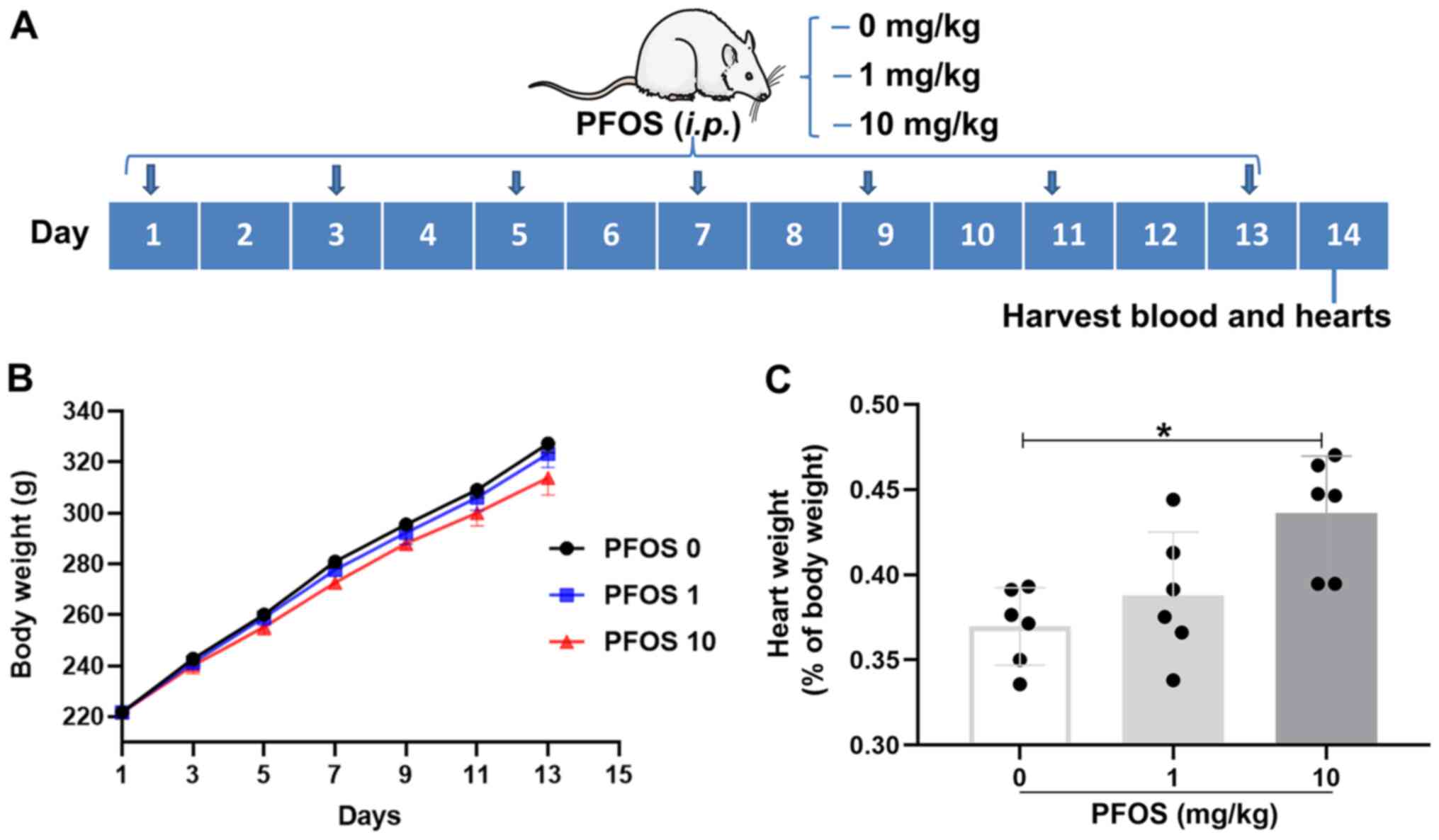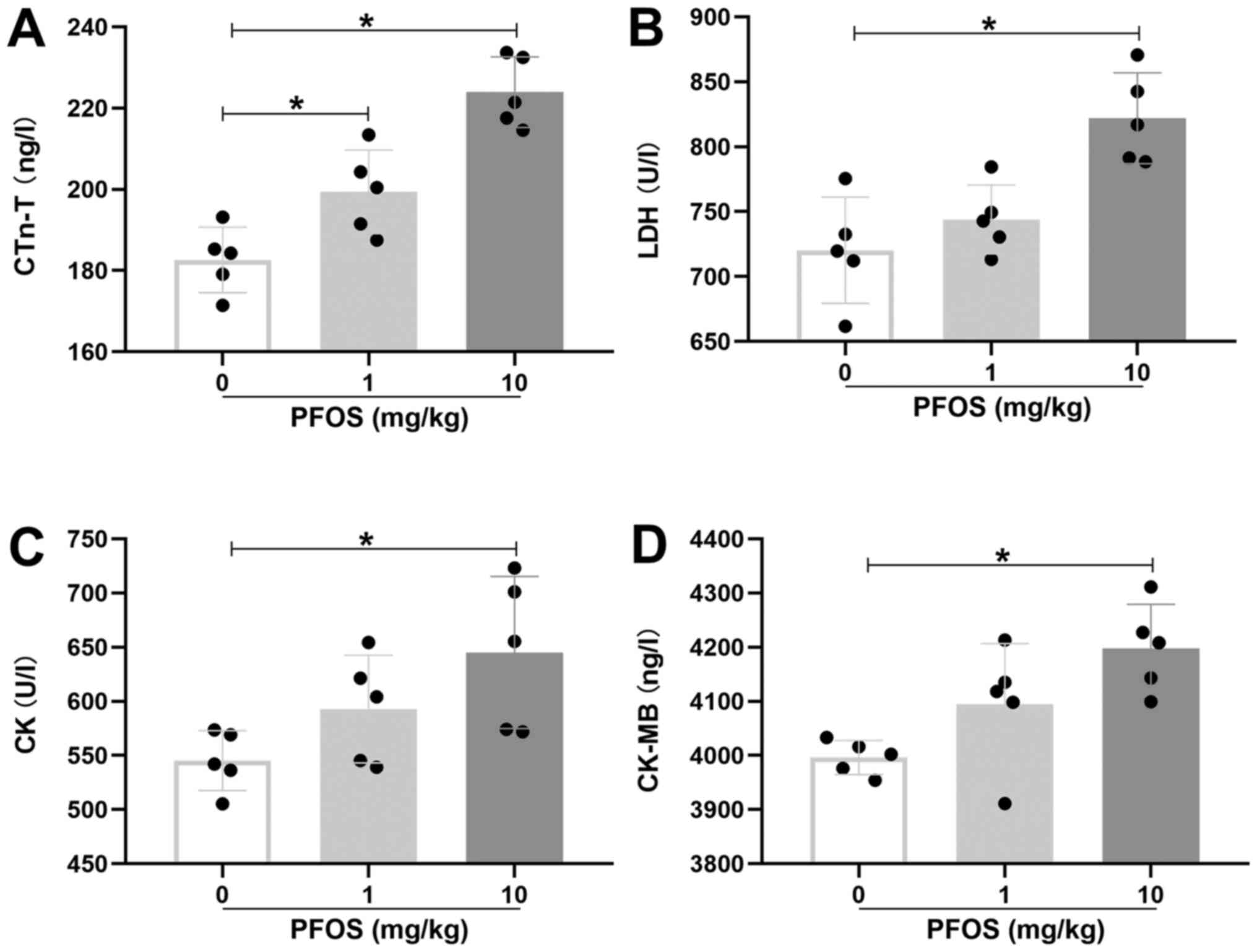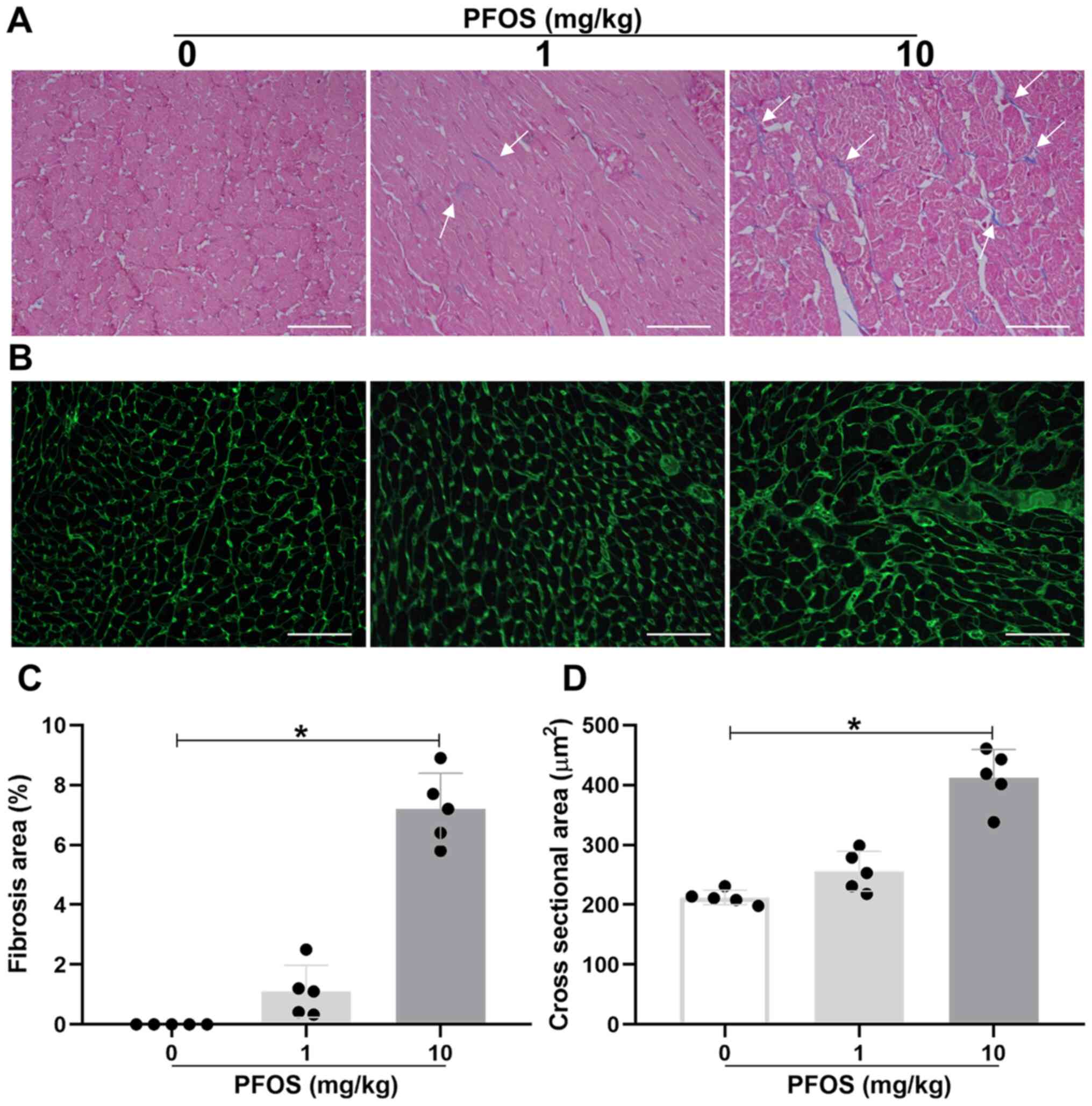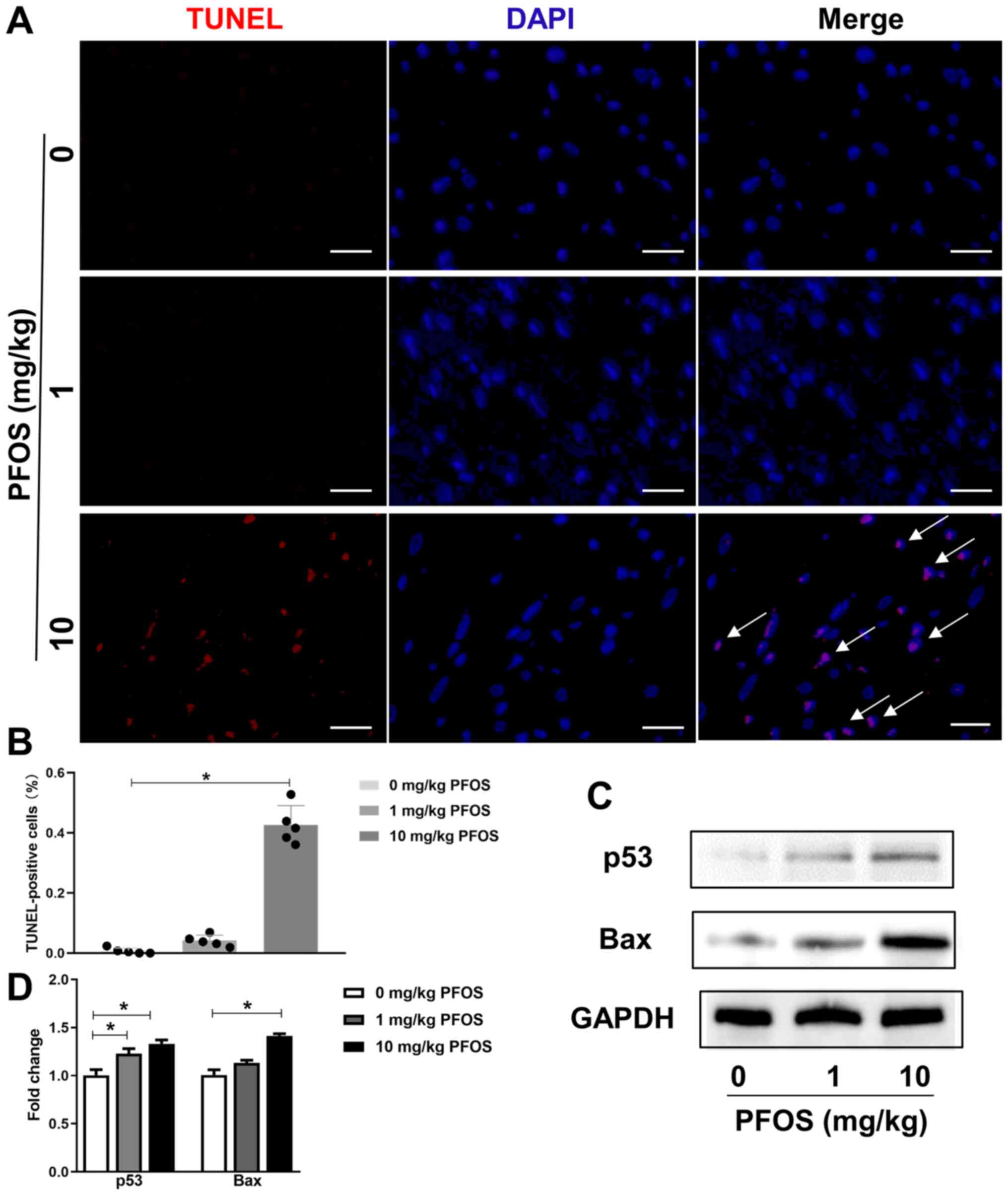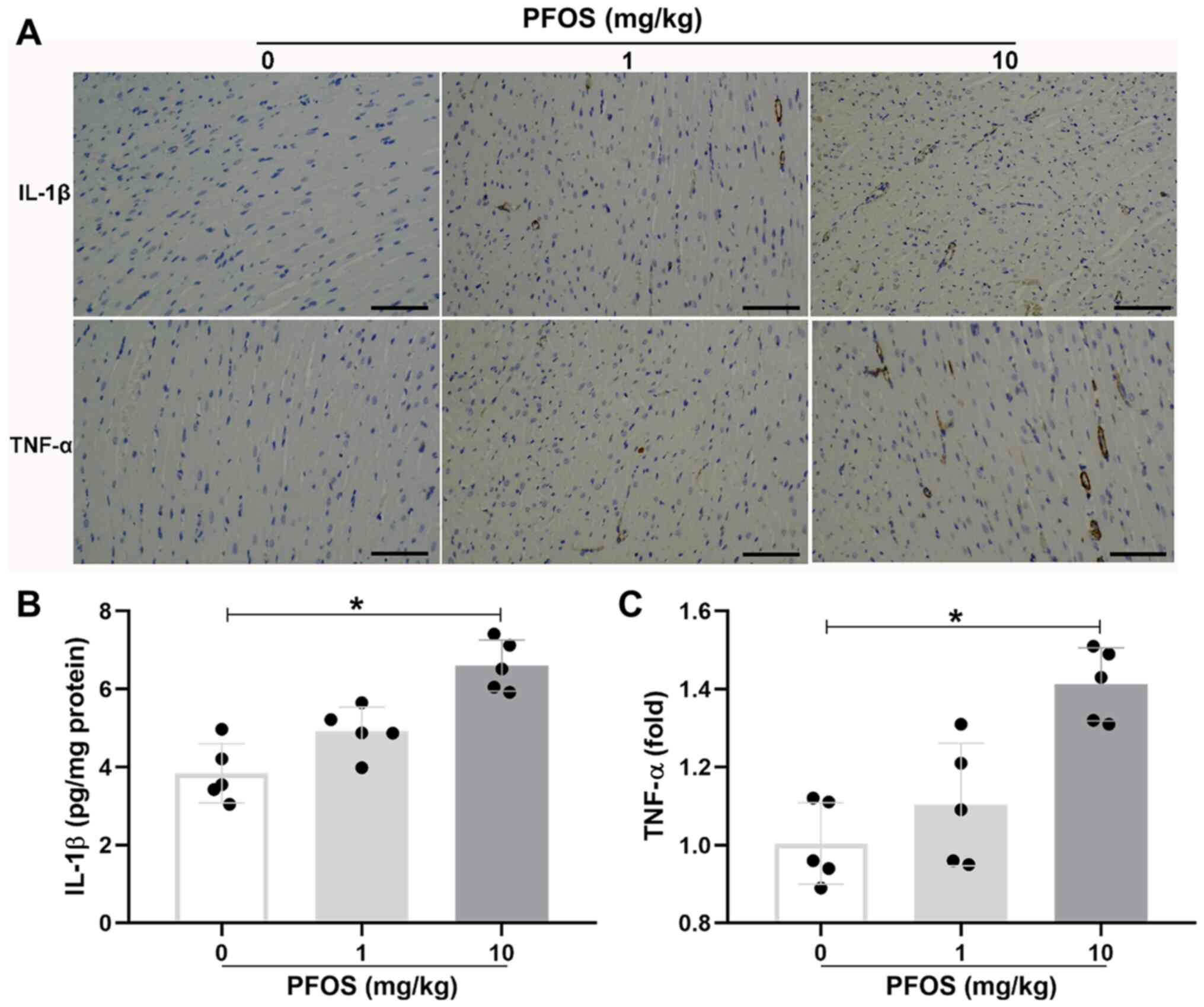|
1
|
Wang G, Sun S, Wu X, Yang S, Wu Y, Zhao J,
Zhang H and Chen W: Intestinal environmental disorders associate
with the tissue damages induced by perfluorooctane sulfonate
exposure. Ecotoxicol Environ Saf. 197(110590)2020.PubMed/NCBI View Article : Google Scholar
|
|
2
|
Gao Y, Guo X, Wang S, Chen F, Ren X, Xiao
H and Wang L: Perfluorooctane sulfonate enhances mRNA expression of
PPARγ and ap2 in human mesenchymal stem cells monitored by
long-retained intracellular nanosensor. Environ Pollut.
263(114571)2020.PubMed/NCBI View Article : Google Scholar
|
|
3
|
Olsen GW, Burris JM, Ehresman DJ,
Froehlich JW, Seacat AM, Butenhoff JL and Zobel LR: Half-life of
serum elimination of perfluorooctanesulfonate,
perfluorohexanesulfonate, and perfluorooctanoate in retired
fluorochemical production workers. Environ Health Perspect.
115:1298–1305. 2007.PubMed/NCBI View Article : Google Scholar
|
|
4
|
Lau C, Thibodeaux JR, Hanson RG, Rogers
JM, Grey BE, Stanton ME, Butenhoff JL and Stevenson LA: Exposure to
perfluorooctane sulfonate during pregnancy in rat and mouse. II:
Postnatal evaluation. Toxicol Sci. 74:382–392. 2003.PubMed/NCBI View Article : Google Scholar
|
|
5
|
UNEP: The stockholm convention-national
implementation plans-addressing COP 4 amendments. http://chm.pops.int/Implementation/NIPs/NIPTransmission/tabid/253/Default.aspx.
(accessed on September 7th 2019), 2016.
|
|
6
|
Xie S, Wang T, Liu S, Jones KC, Sweetman
AJ and Lu Y: Industrial source identification and emission
estimation of perfluorooctane sulfonate in China. Environ Int.
52:1–8. 2013.PubMed/NCBI View Article : Google Scholar
|
|
7
|
Wang S, Huang J, Yang Y, Hui Y, Ge Y,
Larssen T, Yu G, Deng S, Wang B and Harman C: First report of a
Chinese PFOS alternative overlooked for 30 years: Its toxicity,
persistence, and presence in the environment. Environ Sci Technol.
47:10163–10170. 2013.PubMed/NCBI View Article : Google Scholar
|
|
8
|
Jin H, Lin S, Dai W, Feng L, Li T, Lou J
and Zhang Q: Exposure sources of perfluoroalkyl acids and influence
of age and gender on concentrations of chlorinated polyfluorinated
ether sulfonates in human serum from China. Environ Int.
138(105651)2020.PubMed/NCBI View Article : Google Scholar
|
|
9
|
Huang Q, Fang C, Wu X, Fan J and Dong S:
Perfluorooctane sulfonate impairs the cardiac development of a
marine medaka (Oryzias melastigma). Aquat Toxicol. 105:71–77.
2011.PubMed/NCBI View Article : Google Scholar
|
|
10
|
Chan E, Burstyn I, Cherry N, Bamforth F
and Martin JW: Perfluorinated acids and hypothyroxinemia in
pregnant women. Environ Res. 111:559–564. 2011.PubMed/NCBI View Article : Google Scholar
|
|
11
|
Elcombe CR, Elcombe BM, Foster JR, Chang
SC, Ehresman DJ and Butenhoff JL: Hepatocellular hypertrophy and
cell proliferation in sprague-dawley rats from dietary exposure to
potassium perfluorooctanesulfonate results from increased
expression of xenosensor nuclear receptors PPARα and CAR/PXR.
Toxicology. 293:16–29. 2012.PubMed/NCBI View Article : Google Scholar
|
|
12
|
Yang L, He L, Xue J, Ma Y, Xie Z, Wu L,
Huang M and Zhang Z: Persulfate-based degradation of
perfluorooctanoic acid (PFOA) and perfluorooctane sulfonate (PFOS)
in aqueous solution: Review on influences, mechanisms and
prospective. J Hazard Mater. 393(122405)2020.PubMed/NCBI View Article : Google Scholar
|
|
13
|
Zhang YY, Tang LL, Zheng B, Ge RS and Zhu
DY: Protein profiles of cardiomyocyte differentiation in murine
embryonic stem cells exposed to perfluorooctane sulfonate. J Appl
Toxicol. 36:726–740. 2016.PubMed/NCBI View
Article : Google Scholar
|
|
14
|
Cheng W, Yu Z, Feng L and Wang Y:
Perfluorooctane sulfonate (PFOS) induced embryotoxicity and
disruption of cardiogenesis. Toxicol In Vitro. 27:1503–1512.
2013.PubMed/NCBI View Article : Google Scholar
|
|
15
|
Xia W, Wan Y, Li YY, Zeng H, Lv Z, Li G,
Wei Z and Xu SQ: PFOS prenatal exposure induce mitochondrial injury
and gene expression change in hearts of weaned SD rats. Toxicology.
282:23–29. 2011.PubMed/NCBI View Article : Google Scholar
|
|
16
|
Dong Y, Chen H, Gao J, Liu Y, Li J and
Wang J: Molecular machinery and interplay of apoptosis and
autophagy in coronary heart disease. J Mol Cell Cardiol. 136:27–41.
2019.PubMed/NCBI View Article : Google Scholar
|
|
17
|
Tomei LD and Umansky SR: Apoptosis and the
heart: A brief review. Ann N Y Acad Sci. 946:160–168.
2001.PubMed/NCBI View Article : Google Scholar
|
|
18
|
Zeng HC, He QZ, Li YY, Wu CQ, Wu YM and Xu
SQ: Prenatal exposure to PFOS caused mitochondia-mediated apoptosis
in heart of weaned rat. Environ Toxicol. 30:1082–1090.
2015.PubMed/NCBI View Article : Google Scholar
|
|
19
|
Zhang Y, Beesoon S, Zhu L and Martin JW:
Isomers of perfluorooctanesulfonate and perfluorooctanoate and
total perfluoroalkyl acids in human serum from two cities in North
China. Environ Int. 53:9–17. 2013.PubMed/NCBI View Article : Google Scholar
|
|
20
|
Shi X, Du Y, Lam PK, Wu RS and Zhou B:
Developmental toxicity and alteration of gene expression in
zebrafish embryos exposed to PFOS. Toxicol Appl Pharmacol.
230:23–32. 2008.PubMed/NCBI View Article : Google Scholar
|
|
21
|
Shi X and Zhou B: The role of Nrf2 and
MAPK pathways in PFOS-induced oxidative stress in zebrafish
embryos. Toxicol Sci. 15:391–400. 2010.PubMed/NCBI View Article : Google Scholar
|
|
22
|
Han R, Zhang F, Wan C, Liu L, Zhong Q and
Ding W: Effect of perfluorooctane sulphonate-induced Kupffer cell
activation on hepatocyte proliferation through the
NF-κB/TNF-α/IL-6-dependent pathway. Chemosphere. 200:283–294.
2018.PubMed/NCBI View Article : Google Scholar
|
|
23
|
National Research Council: Guide for the
Care and Use of Laboratory Animals: Eighth Edition. The National
Academies Press, Washington, DC, 2011.
|
|
24
|
Chou HC, Wen LL, Chang CC, Lin CY, Jin L
and Juan SH: From the cover: l-carnitine via PPARγ- and
sirt1-dependent mechanisms attenuates epithelial-mesenchymal
transition and renal fibrosis caused by perfluorooctanesulfonate.
Toxicol Sci. 160:217–229. 2017.PubMed/NCBI View Article : Google Scholar
|
|
25
|
Wen LL, Lin CY, Chou HC, Chang CC, Lo HY
and Juan SH: Perfluorooctanesulfonate mediates renal tubular cell
apoptosis through PPARgamma inactivation. PLoS One.
11(e0155190)2016.PubMed/NCBI View Article : Google Scholar
|
|
26
|
Zhang L, Duan X, Sun W and Sun H:
Perfluorooctane sulfonate acute exposure stimulates insulin
secretion via GPR40 pathway. Sci Total Environ.
726(138498)2020.PubMed/NCBI View Article : Google Scholar
|
|
27
|
Calafat AM, Wong LY, Kuklenyik Z, Reidy JA
and Needham LL: Polyfluoroalkyl chemicals in the U.S. population:
Data from the national health and nutrition examination survey
(NHANES) 2003-2004 and comparisons with NHANES 1999-2000. Environ
Health Perspect. 115:1596–1602. 2007.PubMed/NCBI View Article : Google Scholar
|
|
28
|
Yan G: Environmental behavior and human
exposure to perfluoroalkyl acids around a manufacturing facility in
China. Graduate University of the Chinese Academy of Sciences,
2017.
|
|
29
|
3M: Perfluorooctane Sulfonate: Current
Summary of Human Sera, Health and Toxicology Data. 1st edition.
U.S. Environmental Protection Agency, St. Paul, MN, pp1-129,
1999.
|
|
30
|
Harada K, Xu F, Ono K, Iijima T and
Koizumi A: Effects of PFOS and PFOA on L-type Ca2+ currents in
guinea-pig ventricular myocytes. Biochem Biophys Res Commun.
329:487–494. 2005.PubMed/NCBI View Article : Google Scholar
|
|
31
|
Thibodeaux JR, Hanson RG, Rogers JM, Grey
BE, Barbee BD, Richards JH, Butenhoff JL, Stevenson LA and Lau C:
Exposure to perfluorooctane sulfonate during pregnancy in rat and
mouse. I: Maternal and prenatal evaluations. Toxicol Sci.
74:369–381. 2003.PubMed/NCBI View Article : Google Scholar
|
|
32
|
Huang H, Huang C, Wang L, Ye X, Bai C,
Simonich MT, Tanguay RL and Dong Q: Toxicity, uptake kinetics and
behavior assessment in zebrafish embryos following exposure to
perfluorooctanesulphonicacid (PFOS). Aquat Toxicol. 98:139–147.
2010.PubMed/NCBI View Article : Google Scholar
|
|
33
|
Tang LL, Wang JD, Xu TT, Zhao Z, Zheng JJ,
Ge RS and Zhu DY: Mitochondrial toxicity of perfluorooctane
sulfonate in mouse embryonic stem cell-derived cardiomyocytes.
Toxicology. 382:108–116. 2017.PubMed/NCBI View Article : Google Scholar
|
|
34
|
Xu M, Liu G, Li M, Huo M, Zong W and Liu
R: Probing the cell apoptosis pathway induced by perfluorooctanoic
acid and perfluorooctane sulfonate at the subcellular and molecular
levels. J Agric Food Chem. 68:633–641. 2020.PubMed/NCBI View Article : Google Scholar
|
|
35
|
Zhang L, Li YY, Zeng HC, Li M, Wan YJ,
Schluesener HJ, Zhang ZY and Xu SQ: Perfluorooctane sulfonate
induces apoptosis in N9 microglial cell line. Int J Toxicol.
30:207–215. 2011.PubMed/NCBI View Article : Google Scholar
|
|
36
|
Hu XZ and Hu DC: Effects of
perfluorooctanoate and perfluorooctane sulfonate exposure on
hepatoma Hep G2 cells. Arch Toxicol. 83:851–861. 2009.PubMed/NCBI View Article : Google Scholar
|
|
37
|
Kim HS, Jun Kwack S, Sik Han E, Seok Kang
T, Hee Kim S and Young Han S: Induction of apoptosis and CYP4A1
expression in sprague-dawley rats exposed to low doses of
perfluorooctane sulfonate. J Toxicol Sci. 36:201–210.
2011.PubMed/NCBI View Article : Google Scholar
|
|
38
|
Shen Y and White E: p53-dependent
apoptosis pathways. Adv Cancer Res. 82:55–84. 2001.PubMed/NCBI View Article : Google Scholar
|
|
39
|
Fang X, Zou S, Zhao Y, Cui R, Zhang W, Hu
J and Dai J: Kupffer cells suppress perfluorononanoic acid-induced
hepatic peroxisome proliferator-activated receptor α expression by
releasing cytokines. Arch Toxicol. 86:1515–1525. 2012.PubMed/NCBI View Article : Google Scholar
|
|
40
|
Xu Y, Li Y, Scott K, Lindh CH, Jakobsson
K, Fletcher T, Ohlsson B and Andersson EM: Inflammatory bowel
disease and biomarkers of gut inflammation and permeability in a
community with high exposure to perfluoroalkyl substances through
drinking water. Environ Res. 181(108923)2020.PubMed/NCBI View Article : Google Scholar
|
|
41
|
Qiu Z, Qu K, Luan F, Liu Y, Zhu Y, Yuan Y,
Li H, Zhang H, Hai Y and Zhao C: Binding specificities of estrogen
receptor with perfluorinated compounds: A cross species comparison.
Environ Int. 134(105284)2020.PubMed/NCBI View Article : Google Scholar
|
|
42
|
Xu C, Jiang ZY, Liu Q, Liu H and Gu AH:
Estrogen receptor beta mediates hepatotoxicity induced by
perfluorooctane sulfonate in mouse. Environ Sci Pollut Res Int.
24:13414–13423. 2017.PubMed/NCBI View Article : Google Scholar
|
|
43
|
Peden-Adams MM, Keller JM, Eudaly JG,
Berger J, Gilkeson GS and Keil DE: Suppression of humoral immunity
in mice following exposure to perfluorooctane sulfonate. Toxicol
Sci. 104:144–154. 2008.PubMed/NCBI View Article : Google Scholar
|















